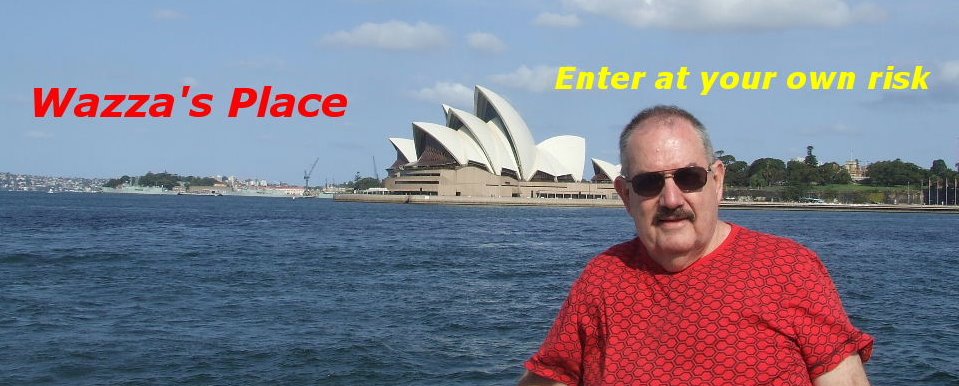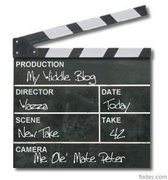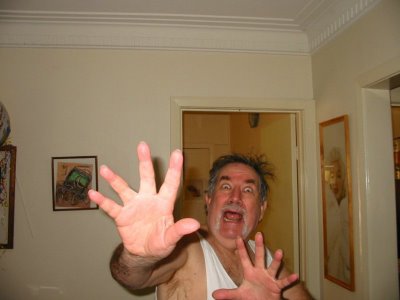Brisbane to Perth with Holtie Part 4
I omitted a couple of places from my last post as I’m sure
these will be of interest.
The first was a place called the Blue Heelers Hotel
at Kynuna on the
Winton. There is only a population of about 19, one hotel and one
garage (gas station) and the walls are covered with graffiti and
signatures from all over
Kynuna Surf Festival, held in aid of the Royal flying Doctor Service.
Surf festival you say? There's heaps of sand in the area but no sea,
but this doesn’t stop the local or hundreds of visitor from attending
the festival.  A couple of tourists, with one sitting on the Surf Lifesaver's Stand.
A couple of tourists, with one sitting on the Surf Lifesaver's Stand.

Three different views of the graffiti and signatures at the Hotel.


The Blue Heelers Hotel is named after
hardest working dog — the Blue Heeler.
The Australian Cattle Dog was developed by pioneer settlers in
the 19th century to herd cattle on large ranches. The Australian
Cattle Dog primarily derived from a mix of smooth, blue speckled
Collie imports from
Kelpie, Dalmatian, and Bull Terrier were also added. The result was
an excellent herding dog, with few equals, who worked the stock
quietly yet forcefully, willing and able to drive cattle across vast
distances under harsh, hot dusty conditions.
Three Blue Heelers "working Cattle" in Outback Queensland.
The other place I forgot to mention was the Walkabout Creek Hotel,
which was featured in the original Crocodile Dundee movie as
McKinlay Hotel. It was renamed after the movie was made and
it has since been was sold for $290,000 after the movie had been
made. We stopped at the hotel, went inside, had a beer, we were
the only patrons, had a look around, then continued on our trip.
 The Walkabout Hotel from the Crocodile Dundee Movie.
The Walkabout Hotel from the Crocodile Dundee Movie. The
Hotel was named after the
and named by the explorer John McKinlay. McKinlay had arrived in
bushman that he was chosen to lead the South Australian Burke
Relief Expedition to search for the missing Burke and Wills.
We arrived at Timber Creek early in the morning after our quick
retreat from “the attack of bush flies” where we had camped the
previous evening. Here we stopped for a "fly free" breakfast at
the local service station. With only a population of 150, fishing
is one of Timber Creek's biggest draw cards. The beautiful
the
In 1855 the explorer A. C. Gregory, who was financially backed
by the Colonial Office to explore the area, sailed from
and up the estuary of the
wrecked at the site of Timber Creek. It is claimed that Gregory
named the site Timber Creek after he had cut some timber to
repair the hole in his vessel. The site of Gregory's camp, known
as Gregory's Tree Reserve, can still be found to the west of the
town. It is distinguished by a cairn. The baob tree with the date
'
which runs from the cairn on the
which is located at the riverside. The inscription on the cairn
reads: 'Gregory's Tree. Sailing from
Australian expedition landed at the
upstream establishing their main base camp near here in October
1855.
 Launching a boat at the Victoria River, but beware!!
Launching a boat at the Victoria River, but beware!! The reason why one should be very careful on the Victoria River.
The reason why one should be very careful on the Victoria River.
According to Aboriginal legend, the boab tree misbehaved and was
therefore stuck in the ground upside-down, with its roots in the air.
The huge boab tree, found only in the Western Australia Kimberley
region, is used as food, medicine, shelter, for art work and even as
a prison cell.
The boab tree has long been used as a staple food source by
the aboriginal people. Studies on the African species have
shown parts of the tree to be exceptionally high in Vitamin C,
more than ten times the Vitamin C content of oranges!
The Australian boab tree is not as well studied, but it is known
that the seeds are very high in Vitamin C as well.
Overlooking part of the township of Kununurra.
Our next stop was Kununurra, some 230km down the
Highway
in the
advertisement that was shown some years ago which said
“you’d never, never know if you never, never go”. Apparently
the ad was so popular that the number of tourists visiting the
Kununurra is a local aboriginal word meaning “Meeting Of Big
Waters”. The town was established in the early 1960s as a
service town for the Ord River Irrigation Scheme. The population
is around 5000 and because of the
attraction is tourism and agriculture. The main crops are water
melons, bananas, mangoes, pumpkins and cucumber.
In the early days of the Ord River Scheme peanuts and rice
were two crops grown commercially.
Magpie Geese in huge numbers were a major cause for the
ending of rice as a commercial crop.

Magpie Geese flying by the airport were estimated at a rate of
80,000 per hour caused MacRobertson Miller Airlines to alter
their flight schedule so that sunrise and sunset arrival times
were avoided due to magpie geese conflicting with aircraft

Just 2km from Kununurra is the 350 million year old Mirima
valleys dotted with green bushes and some trees.
In conjunction with the blue sky there is a fascinating mix of
colours, which is best viewed early in the morning.
The locals call the
you can discover the treasures of this hidden valley on several
walks along the valleys and ridges.
Four different views of the sandstone formation in Hidden Valley.
The sandstone formation was created over millions of years from
the huge downpour of wind and rain during the wet season, then
from the heat of the dry season that cracked and formed the
strange intricate shapes and colours.
From Kununurra our next overnight stay was at
a easy 50km journey, where we planned to camp for the next
two days.
was formed when the Ord River was dammed in the late 1960s
and stores 10,760 million cubic metres of water or about nine
times the size of Sydney Harbour. Lake Argyle is also
largest man-made reservoir.
Three magnificent scenes taken overlooking Lake Argyle.
The area was first settled by Patrick Durack in 1882. Durack
was born in
Wales
diggings in
tributary of
endlessly energetic and quickly established himself as one of
the richest and most successful cattle owners in the area.
In the early 1880s, after hearing good reports of the
country, he sent his brother Michael to inspect land on the
droving of 7250 breeding cattle and 200 horses to the region.
The 3000 mile and three year long trek of cattle from
to stock the Argyle and Ivanhoe stations was, at the time, the
longest ever attempted in
In Part 5 we continue our visit to
Wyndham on the coast where the Five Rivers join. The views
from the lookout especially at dusk are spectacular.


















7 comments:
hello```
my name is lily``
welcome to my blog http://www.lilysweetroom.blogspot.com
thank you`````!
Hi Wazza, another good episode although we drove there and saw it all a lot quicker than you are telling the story!!
Hi Warren -- Thanks for that. Your descriptive journey tales are soooo interesting.
And Happy Easter!
..
Hi Warren again.
I just went to JoyZine - Big Red Tour Through Outback Australia - Chapter 16 Surgeons and Nurses to learn more of the Boab Tree. Very interesting there.
http://www.artistwd.com/joyzine/australia/big_red/br_16.php
Did you ever go there?
..
After the
'16.' above put 'php'
..
Another fabulous post!
Thank you for taking us on the journey with you.
Hugs
Hi Wazza...great pic and great travelogue full of good information...I almost had a job at the Blue Heeler at Kynuna a few years ago, back in the nineties, but I changed my mind...that heat and all those flies...I thought the better of it. Still would have been a good experience, though.
Thanks for sharing. :)
Post a Comment